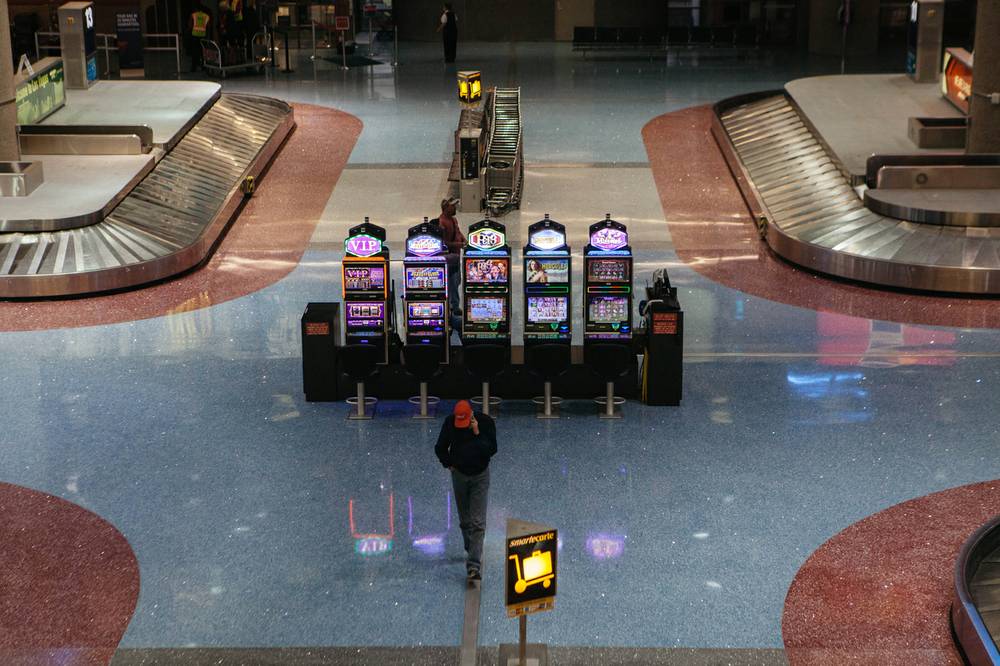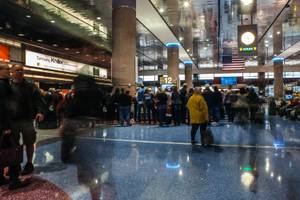On September 11, 2001, terrorists seized control of several domestic airline flights and crashed them into the World Trade Center, the Pentagon and a field in southern Pennsylvania. The consequences of that horrible day are well known and, sadly, ongoing. But one relatively minor, short-term local consequence of the attacks might be forgotten over time: As a result of a federal order that shut down America’s civilian airspace, McCarran International Airport was closed for three days.
At the time of the attacks I was working as a film critic for the Las Vegas Sun. That morning, I attended a critic’s screening of Ghost World—whose insistently cynical tone cheered me up not at all—and after that I drove to the office by way of the airport bypass road, because I wanted to know what McCarran’s off-switch looked like. It was, predictably, an eerie sight. Dozens of planes were parked around the D Gates, lined up in mute rows. The access roads were clear of taxis, buses and limousines; even the runway tunnel was largely empty of private cars. And all day after that, I looked out the windows of the Sun’s Henderson office at those empty skies, a sad thought cycling through my head over and over: This town’s doomed without tourists.
That bad day was one of the factors that compelled me to move to Seattle eight months later. And though I don’t regret that decision, I do feel a little foolish now that I’m chatting with Christine Crews, McCarran’s public affairs administrator, on an information-packed walking tour of the airport. One of the first things she tells me is that McCarran was the first airport in America to reopen in the wake of 9/11.
“You can probably imagine, given the number of people we have at any time in this city, how many people wanted to get home,” she says.
I don’t say anything, don’t mention the sort-of premonition that drove me out of Vegas, because I realize I actually hadn’t thought about that in 2001—about all the people sitting in their hotel rooms anxiously waiting to leave. I was too busy reeling from the sudden, astonishing realization that our city has a window than can be shut.
The Middle
McCarran is my favorite national airport, hands down. To my mind it doesn’t even have close competition, despite a recent J.D. Power study that ranked it third, below Portland International and Tampa International, in overall customer satisfaction (28 other airports scored below ours). I like bits of other airports—the concessions at Atlanta’s Hartsfield-Jackson, the Eero Saarinen-designed TWA Flight Center at New York’s Kennedy and, sure, the iconic carpeting at Portland International, an inexplicable social media darling—but none of them can stand up to McCarran, for one reason above all: I don’t have to think about being there, because I’m never there for long.
McCarran is located more or less in the center of town. It’s been in the same place since 1948, when that South Strip location was considered remote—indeed, many years before we even coined the phrase South Strip. One of the questions Crews frequently gets asked by newcomers is, “What idiot decided to put an airport in the middle of town?”—as if a major international airport would choose to squeeze itself into an already-packed resort corridor, where its expansion possibilities are limited. On speaking engagements, she usually shows a slide of the airport’s look in the 1950s—located several miles away from the closest hotel, just runways cut into open desert.
But McCarran’s strange location is also its greatest asset. The reason McCarran doesn’t have a ton of amenities in its terminals—it doesn’t have Atlanta’s endless variety of restaurants, for example, or an on-site hotel, like you’ll find in Orlando—is because Las Vegas itself is the terminal. You can finish a meal at the Cosmopolitan and be at a TSA checkpoint 15 minutes later. Conversely, you can land at McCarran and start gambling within 15 minutes—or less, since Nevada is the only state that allows gaming in its airports, at least for now. (Reportedly, Illinois is considering it for Chicago’s airports.)
To locals, that central location means something else entirely. If you text me at wheels down, I can drive to McCarran in just about the time it takes you to disembark, get your luggage and walk to passenger pickup. (By comparison: Seattle-Tacoma International is a good half-hour drive from downtown Seattle in favorable traffic, and LAX is 17 miles from downtown LA on largely impassable streets.) It also means we can fly out of our airport and land at another one in less time than travelers in other cities spend waiting for snowplows to clear a runway.
Crews puts it best. “One of the beautiful things about living here is the connectivity we have to the world,” she says. “We serve about 150 different destinations, more than 20 of them international, with 30 different airlines—and because Las Vegas is a leading destination, the airlines usually post low-cost fares for it. We benefit from that, because it’s a low-cost ticket to anywhere we might want to go.”
I know a number of people who have taken full advantage of that: friends who use McCarran as a conduit to a quality of medical treatment they feel they can’t get here; friends who have worked jobs in Vegas but have maintained residences in San Francisco and New York City, treating McCarran as one would a small-town commuter airport. One of the latter sort, a circus performer, worked it backwards: He bought a house here and commutes to Manhattan, applying that city’s higher wages to Las Vegas’ more reasonable cost of living. “I’m trying to talk more of my friends into doing it,” he says, “because your airport is so easy.”
McCarran’s central location has one other benefit, though I might be one of very few who fully appreciates it: No matter where I am in this Valley and no matter the time of day, I can go outside, look up and receive conclusive evidence that Vegas is still working. As long as I see planes in the sky, money is being flown into our economy and left here.
McCarran mauve
The 1980s expansion projects that created Terminal 1’s baggage claim and the C Gates brought with it a color scheme McCarran employees “affectionately and not-so-affectionately refer to as ‘McCarran mauve,’” Crews jokes. It’s still on the walls of Terminal 1, both inside and out. But it’s beginning to be replaced—an in-progress remodel of baggage claim and ticketing, which is removing the tile-and-carpet floors in favor of glittering terrazzo, is slowly stripping away the McCarran mauve of our forebears.
“There’s an effort to phase it out, but it won’t completely disappear,” she says, acknowledging that people have grown fond of it (as they have of the mirrored “disco ceiling”). Part of Crews’ job is to watch for mentions of the airport on social media, and more than once during our walk through the terminals, she references passenger reaction to various aspects of McCarran—they love this, they didn’t like that, something confused them at first.
More
It’s wholly understandable that the airport would want to keep tabs on how visitors regard McCarran—it is, after all, the first and last impression most tourists have of Vegas. But the passion for McCarran mauve hews closer to home. It comes from a place similar to New York’s love of Saarinen’s TWA terminal, or Portland’s hipster-bred love of its damn terminal carpeting. It says locals are becoming fond of McCarran, and want it to hold on to its character, even as it grows steadily larger, busier and more modern.
The evidence of that modernization effort is visible everywhere we turn. The ticketing windows look cleaner—they’re now lined with sand-colored stone—and they’re being reconfigured to be more like those in Terminal 3, which feature “dynamic signage” and flexible-use counters. That means the windows used by British Airways in the morning can be run by Hainan Airlines in the afternoon.
McCarran has technological capacities that are in some cases more advanced than those of the airlines themselves. Crews likens the process of updating to “changing the wheels on a car that’s going 100 miles per hour,” which many airlines aren’t keen to do. “We often take an ‘If we build it, we’ll wait for them to come along’ approach,” she says.
There might be no better example of this—or a more optimistic indicator that we’ve successfully weathered a recession—than the way McCarran is, in its way, already outgrowing Terminal 3, which opened just five years ago with seven international gates. Seven more are being added by converting a wing of the D Gates.
“The capacity constraints of an airport are always going to be airways, roadways, terminals,” Crews says. “With the addition of Terminal 3, we expanded that capacity [by] being able to switch out and maximize what we have.”
The new international D Gates will have sterile corridors and a tunnel leading directly to the customs and border control facilities in Terminal 3. McCarran will equip one of those new gates with a dual jetbridge to accommodate an Airbus A380—the largest passenger airline in the world. No airline has yet landed one in Vegas, but McCarran will be ready when one does. “Gotta have it before they want it,” Crews says.
And even though McCarran moved 47.4 million passengers last year, Crews doesn’t sound worried about bumping against the airport’s estimated maximum capacity of 55 million. “Growth isn’t a straight line,” she says. “And there’s a federal program called NextGen [currently in development] that will take air traffic controls from being radar-based to GPS-based. That would increase our capacity as far as airspace goes.”
The future sorted away, Crews and I happily talk about McCarran of the present. (You might have guessed by now that I’m an unapologetic transit infrastructure geek.) As we wander, she provides me with a raft of facts and figures. I learn that taxi queues at both terminals are 10 lanes across, and on busy days, they’re completely full. And that $2 surcharge cabs, Uber and Lyft add to fares? It’s necessary to maintain the facilities those services use.
“McCarran is an enterprise fund facility,” Crews says. “The airport operates on money that is spent here, fees that are charged here. We don’t take any property taxes or anything like that. … It all has to be paid for somehow. The parking structure—it has to be lit, has to be maintained, has to be staffed. If we didn’t do a direct user charge, it would have to go into the overall operating budget of the airport, which would then be reflected in the cost of your plane tickets.”
She shows me some of the Easter eggs the airport has hidden in plain sight: a display of vintage airline advertising materials in the C Gates; the Hacienda Hotel-sponsored Cessna 172—suspended from the ceiling over baggage claim—that spent a continuous 64 days, 22 hours and 19 minutes aloft in the winter of ’58 (a record that still stands); the photomosaic murals in the D Gates, created from hand-drawn art by 30,000 Clark County schoolkids; the markers for the Fly Fit in-terminal walking trails, intended for passengers with edema concerns; and even the tiny, shadowy silhouette of Howard Hughes hidden in a terrazzo floor mural of the Vegas skyline, recently created by artist Randy Heil for Terminal 1’s baggage claim (look in the windows of the Desert Inn).
But one of the things she points out is visible to all: the “Welcome to Las Vegas” sign in the D Gates, which debuted with the 1998 addition. Crews beams as she addresses it. “I think there are things that we locals take for granted, or think we’re too cool for,” she says, “but this is one of the most-photographed locations in all of Las Vegas.”
“It’s our Portland carpet,” I suggest.
And just then, I remember something: When I returned to Las Vegas from Seattle in 2012, I arrived at the D Gates. I walked briskly through the terminal, eager to get to baggage claim, but I stopped briefly at that sign and snapped a picture of it with my phone, even though there are probably a thousand similar photos online. I posted it to my Facebook page, with the simple caption “I’m back.” Ten years after McCarran saw me change my Vegas story, it enabled me to pick it right back up. The window swung open, like nothing had happened at all.





